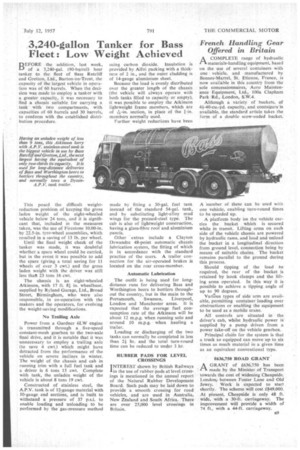3,240-gallon Tanker. for Bass Fleet: Low Weight Achieved
Page 43

If you've noticed an error in this article please click here to report it so we can fix it.
DEFORE the addition, last week, 1.-/ of a 3,240-gal. (90-barre1) beer tanker to the fleet of Bass Ratcliff and Gretton, Ltd., Burton-on-Trent, the capacity of the largest vehicle in operation was of 60 barrels. When the decision was made to employ a tanker with a greater capacity, it was necessary to find a chassis suitable for carrying a tank with two compartments, with capacities of 60 barrels and 30 barrels, to conform with the established distribution procedure.
This posed the difficult weightreduction problem of keeping the gross laden weight of the eight-wheeled vehicle below 24 tons, and it is significant that, included in the measures taken, was the use of Firestone 10.00-in. by 22.5-in. tyre-wheel assemblies, which resulted in a saving of 13 lb. per wheel.
Until the final weight check of the tanker was made, it was doubtful whether a spare wheel could be carried, but in the event it was possible to add the spare (giving a total saving for 11 wheels of over 3 cwt.) and the gross laden weight with the driver was still less thafi 23 tons 16 cwt.
The chassis is an eight-wheeled Atkinson, with 17 ft. 81 in. wheelbase, supplied by Ryland Garage, Ltd., Broad Street, Birmingham, who were also responsible, in co-operation with the makers and the operators, for evolving the weight-saving. modifications.
No Trailing Axle Power from a Gardner 6LW engine is transmitted through a . five-speed constant-mesh gearbox to the two-axle final drive, and it is notable that it was unnecessary to employ a trailing axle (to save 4 cwt.) which might have detracted from the performance of the vehicle on severe inclines in winter. The weight of the chassis and cab in running trim with a full fuel tank and a driver is 6 tons 15 cwt. Complete with tank, the unladen weight of the vehicle is about 8 tons 19 cwt.
Constructed of stainless steel, the A.P.V. tank is of 12-gauge material with 10-gauge end sections, and is built to withstand a pressure of ,a7 p.s.i. to enable loading and unloading to be performed by the gas-pressure method using carbon dioxide. Insulation is provided by Alfol packing with a thickness of 2 in., and the outer cladding is of 14-gauge aluminium sheet.
Because the load is evenly distributed over the greater length of the chassis (the vehicle will always operate, with both tanks filled to capacity or empty), it was possible to employ the Atkinson lightweight frame members, which are of A-in. section, in place of the a-in. members normally used.
Further weight reductions have been
made by fitting a 30-gal. fuel tank instead of the standard 54-gal. tank, and by substituting light-alloy mud wings for the pressed-steel type. The cab is also of lightweight construction, having a glass-fibre roof and aluminium panels.
Other extras include a Clayton Dewandre 48-point automatic chassis lubrication system, the fitting of which is in accordance with the standard practice of the users. A trailer connection for the air-operated brakes is located on the rear cross-member.
Automatic Lubrication
The outfit is being used for longdistance runs for delivering Bass and Worthington beers to bottlers throughout the country, but in the main to the Portsmouth, Swansea, Liverpool, London and Manchester areas. It is expected that the average fuel consumption rate of the Atkinson will be about 12 m.p.g. when running solo and around 10 m.p.g. • when hauling a trailer.
Loading or discharging of the two tanks can norinally be completed in less than 2ihr. and the total turn-round time can be reduced to under 3 hr.




































































































